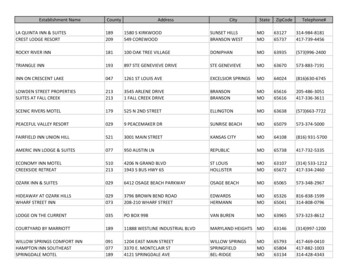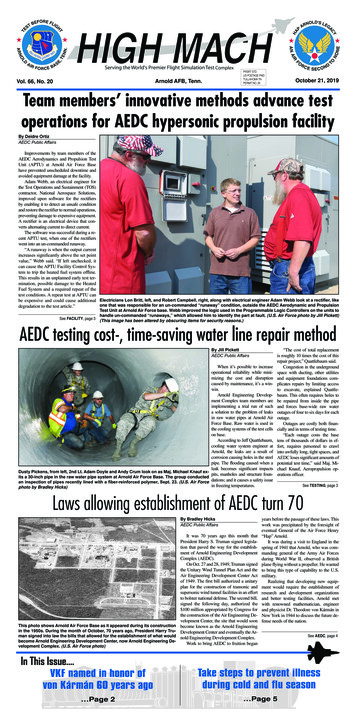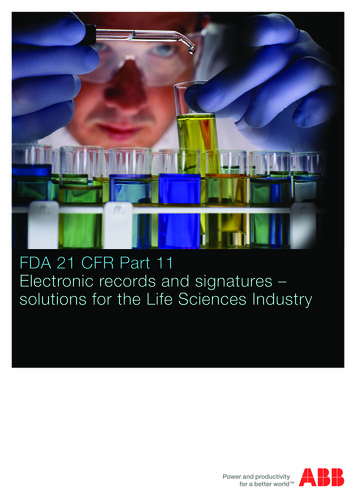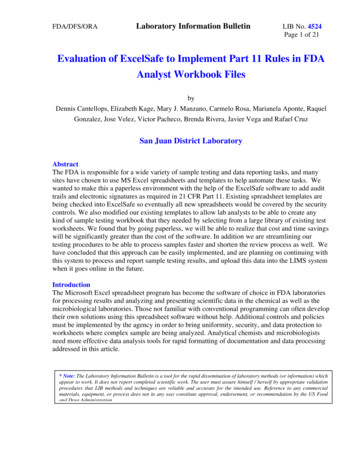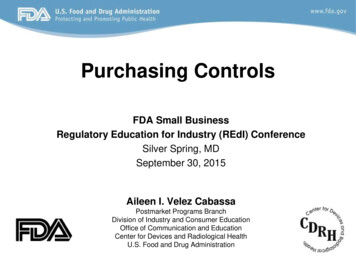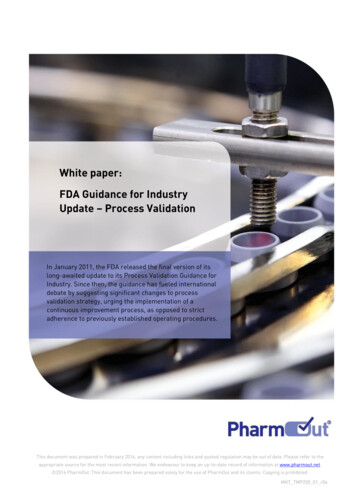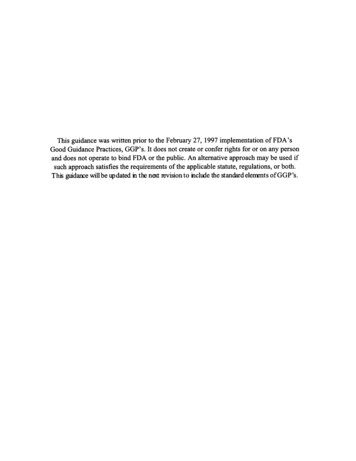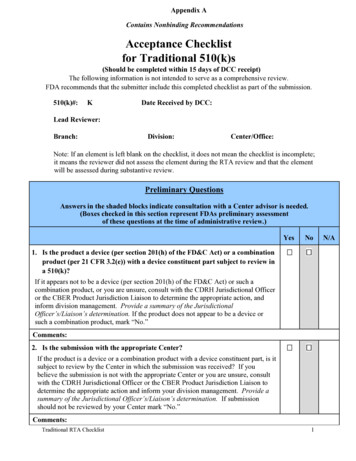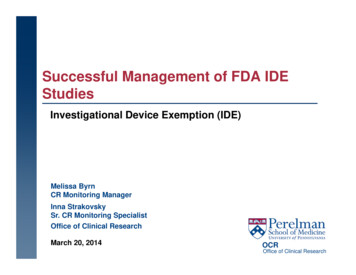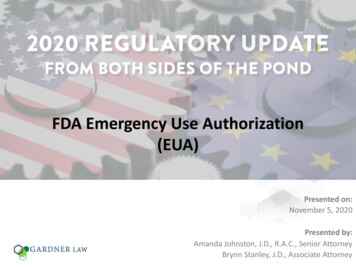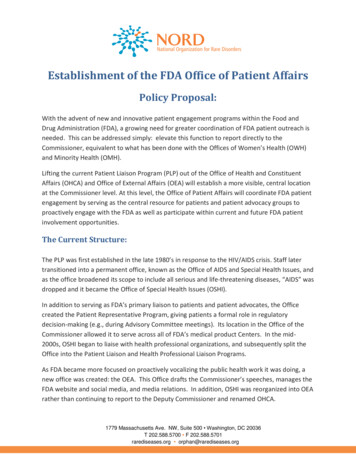
Transcription
Establishment of the FDA Office of Patient AffairsPolicy Proposal:With the advent of new and innovative patient engagement programs within the Food andDrug Administration (FDA), a growing need for greater coordination of FDA patient outreach isneeded. This can be addressed simply: elevate this function to report directly to theCommissioner, equivalent to what has been done with the Offices of Women’s Health (OWH)and Minority Health (OMH).Lifting the current Patient Liaison Program (PLP) out of the Office of Health and ConstituentAffairs (OHCA) and Office of External Affairs (OEA) will establish a more visible, central locationat the Commissioner level. At this level, the Office of Patient Affairs will coordinate FDA patientengagement by serving as the central resource for patients and patient advocacy groups toproactively engage with the FDA as well as participate within current and future FDA patientinvolvement opportunities.The Current Structure:The PLP was first established in the late 1980’s in response to the HIV/AIDS crisis. Staff latertransitioned into a permanent office, known as the Office of AIDS and Special Health Issues, andas the office broadened its scope to include all serious and life-threatening diseases, “AIDS” wasdropped and it became the Office of Special Health Issues (OSHI).In addition to serving as FDA’s primary liaison to patients and patient advocates, the Officecreated the Patient Representative Program, giving patients a formal role in regulatorydecision-making (e.g., during Advisory Committee meetings). Its location in the Office of theCommissioner allowed it to serve across all of FDA’s medical product Centers. In the mid2000s, OSHI began to liaise with health professional organizations, and subsequently split theOffice into the Patient Liaison and Health Professional Liaison Programs.As FDA became more focused on proactively vocalizing the public health work it was doing, anew office was created: the OEA. This Office drafts the Commissioner’s speeches, manages theFDA website and social media, and media relations. In addition, OSHI was reorganized into OEArather than continuing to report to the Deputy Commissioner and renamed OHCA.1779 Massachusetts Ave. NW, Suite 500 Washington, DC 20036T 202.588.5700 F 202.588.5701rarediseases.org orphan@rarediseases.org
Since that time, with the assistance of the PLP, the number of patient engagement programswithin the Centers has expanded considerably.Because of the Office’s increased responsibilities, it is now obvious that with the increasedvisibility of the Office, and its role as the central coordinator of patient engagement, themission of the Office must change.The Need:The FDA’s current structure to ensure the patient’s voice is heard within the drug, biologic, andmedical device development and review processes must be strengthened in several ways. Mostnotably, the following opportunities to improve patient involvement should be addressed:1. Low visibility of Patient Involvement Opportunities – Today, many patients areunaware of opportunities to engage the Agency. This could be addressed by FDA moreproactively engaging the patient community in FDA patient involvement opportunities.While NORD has worked well with OCHA to include patients at every possibleopportunity, many patients and patient organizations are still unaware of thoseopportunities.2. Adverse Conflict-of-Interest Determinations – Patients, their families, and theircaretakers continue to be deemed conflicted under current Federal conflict-of-interestrules due to a misunderstanding of the unique considerations that must be made whenreviewing a patient’s application.This is particularly problematic within the rare disease community, as qualified patientsor patient stakeholders may be seen as conflicted due to their attempts to furtherresearch and therapeutic development related to their disease. Rare diseasecommunities can be quite small, and often an entire stakeholder community can bejudged to be at odds with current laws and regulations, leaving the FDA without apatient representative for an Advisory Committee hearing. Not only does this excludethe patient voice from the process, but it can significantly delay therapeuticdevelopment.3. Confusion on the FDA’s Role in Single-Patient Expanded Access Requests: The recentpassage of state “Right-to-Try” legislation that essentially removes the FDA from thesingle-patient Investigational New Drug (IND) expanded access request process showswidespread confusion of the FDA’s role in granting patients access to investigationaltherapies. The vast majority of expanded access requests are denied by the sponsor ofFDA Office of Patient Affairs – Page 2
the therapy and not by the FDA. In fact, the FDA approves over 99% of single-patientexpanded access requests.1This confusion is due at least in part to the lack of a central FDA location for expandedaccess information and inquiries. Currently, each review division handles single-patientexpanded access requests, but the contact information for the appropriate FDA officialis difficult to find.4. Limited Coordination between Medical Product Centers on Patient EngagementInitiatives: Each therapeutic review division has a variety of valuable opportunities forpatient participation within the drug and device review process. For example, theCenter for Drug Evaluation and Research (CDER) and the Center for Biologics Evaluationand Research (CBER) are each taking part in the Patient-Focused Drug DevelopmentInitiative.The Center for Device and Radiological Health (CDRH) has issued a Draft Guidance on“Patient Preference Information – Submission, Review in PMAs, HDE Applications, andDe Novo Requests, and Inclusion in Device labeling”.2 Most recently, CDRH formed thePatient Engagement Advisory Council to advise CDRH on the patient’s perspective onmedical device development and review.3Each of these initiatives and the many ongoing programs within the current PLP allattempt to include the patient voice in the review process, yet these efforts appear tobe disjointed. There is little awareness of patient engagement opportunities acrosscenters, and patient involvement programs are almost entirely self-contained.The Solution:Many of these problems can be addressed by simply elevating the current PLP from within theOffices of Health and Constituent Affairs and External Affairs by placing the newly-named Office1Tamy Kim, Peter Laurie, and Richard Pazdur, “US Food and Drug Administration Efforts to Facilitate the Use ofExpanded Access Programs” Journal of Clinical Oncology, 17 August 20152U.S. Food and Drug Administration, “Patient Preference Information – Submission, Review in PMAs, HDEApplications, and De Novo Requests, and Inclusion in Device Labeling Draft Guidance for Industry, Food and DrugAdministration Staff, and Other ments/UCM446680.pdf (accessed August 28,2015).3U.S. Food and Drug Administration, “Patient Engagement Advisory oryCommittee/default.htmFDA Office of Patient Affairs – Page 3
of Patient Affairs (the Office) to the Commissioner level currently occupied by OWH and OMH,for example.By advancing this Office, patients and patient advocates will become true partners. The voice ofpatients and patient advocates will strengthen and magnify the patient voice.The responsibilities of this Office, as outlined by our proposed legislative text, include:1. Ensuring Patient Participation Opportunities in the Drug, Biologic, and Medical DeviceReview Processes: With the creation of this Office, patients will be better able to takeadvantage of existing patient involvement opportunities. For example, this Office willmore effectively recruit Patient Representatives to serve as Special GovernmentEmployees (SGEs).This Office will centralize the job of screening patient representative SGE applicants forCOI. This Office will then have the authority to grant waivers under 18 U.S.C. § 208. WithCOI screenings occurring under this Office’s purview, patients and caregivers will bereviewed by experts knowledgeable of the patient experience. This could result in athorough yet expedited review for patient representatives, more a consistent approachto granting waivers.An analogous step the FDA has already taken in recognizing and accommodating uniquecircumstances is the formation of the CDER Office of Rare Diseases. While orphanproducts are held to the same safety and efficacy standards as other medical products,they require special expertise, knowledge, and often flexibility. Similarly, while patientswill have the same protections against conflicted individuals, special expertise andknowledge are needed in assessing their conflict-of-interest determinations.This Office will be charged with training and advising SGE candidates. Additionally, theOffice will also be responsible for keeping a database of qualified patientrepresentatives to take part in patient involvement opportunities.Not only will this elevated Office be valuable in carrying out the FDA’s current patientinvolvement opportunities, but it will also be key in implementing future patientinvolvement programs, including the language in the 21 st Century Cures Act as well asvarious other FDA patient involvement proposals.2. Internal Coordination across the Centers’ Patient Engagement Initiatives: This Officewill be tasked with fostering collaboration across Centers on their patient engagementFDA Office of Patient Affairs – Page 4
initiatives. Without usurping the authority of each Center to plan and implement its ownpatient engagement initiatives, the Office will assist the Centers in coordinating andcollaborating, as well as sharing best practices, on patient engagement initiatives.This can be achieved through the formation of a Patient Engagement Council that will bechaired by the Director of the Office of Patient Affairs. Modeled after the highlysuccessful Rare Diseases Council, this Council will include patient engagementrepresentatives from CDER, CBER, CDRH, CFSAN, OWH, OMH, Offices of Orphan ProductDevelopment and Pediatric Therapeutics, and any other office that is deemedappropriate to participate by the Office of Patient Affairs.This Council will have various duties, including the discussion and sharing of patientengagement and involvement best practices across centers, the development of crossCenter patient involvement opportunities, and the development of patient engagementmodels to be recommended to the Commissioner and public at large. This Council willalso be charged with providing the Commissioner with recommendations for improvingpatient involvement in the drug, biologic, and medical device development and reviewprocesses.3. Serve as the FDA’s External Representative for Patient Affairs: This Office willrepresent the FDA in outside meetings, public appearances, conferences, and otherexternally facing opportunities for the FDA to proactively publicize patient involvementopportunities. This Office will also be tasked with the development and upkeep ofresources for patients to better educate themselves on FDA’s regulatory framework,Agency programs and initiatives, and patient involvement opportunities. Theseresources include, but are not limited to, a patient-centered website and newsletter,similar to the current Patient Network Newsletter.4. Educate and Assist Patients and Physicians Seeking Single-Patient Expanded AccessRequests: With better visibility, accessibility, and ability to work across the Centers, thisOffice will be the sole point-of-contact for incoming single-patient expanded accessquestions and requests. The Office will include dedicated staff, known as the ExpandedAccess Coordination Program, to provide education and information to patients andcaregivers on the regulatory framework for single-patient expanded access requests,but also to serve as the liaison to the appropriate officials within the Agency forcompleting the request.FDA Office of Patient Affairs – Page 5
This Office will also keep a database of expanded access requests, the FDA decision onthe expanded access request, and the result of the expanded access treatment. Thisdatabase, which does not exist currently, will allow the FDA to track the results of usingan investigational therapy, and will equip Congress and the public at large with data andinformation on the expanded access environment, something that is currently missing.This Office will not have any additional regulatory authority on expanded accessrequests, and the decision to grant a request will remain in the hands of the reviewdivisions. Instead, this Office will simply streamline the process in order to make it moretransparent for patients and their caregivers.5. Report to the Commissioner on Patient Engagement throughout the Centers: TheOffice of Patient Affairs will be responsible for reporting regularly to the Commissioneron all patient engagement and involvement initiatives occurring within the Office andCenters. By elevating this Office to the level directly below the Commissioner, top FDAand Administration officials will be better informed on input solicited from patients andpatient advocacy groups, the Centers’ individual patient engagement initiatives, theAgency’s overarching patient engagement initiatives, and how the Agency and theAdministration may stimulate increased patient involvement.6. Report to Congress Biennially on Patient Involvement in FDA Practices: This Office willbe responsible for reporting to Congress every two years on the FDA’s patientengagement initiatives, and evaluating the progress made within these programs ininvolving patients. This two-year report should not be overly burdensome on the FDA toproduce, and should inform Congress and the general public of opportunities forpatients to become involved in FDA practices.FDA Office of Patient Affairs – Page 6
Proposed Legislative LanguageA BILLTo improve the safety, efficacy, and security of human medical products and improve the publichealth through the establishment of the Office of Patient Affairs within the Food and DrugAdministration.Section 1. Short TitleThis Act may be cited as the “Food and Drug Administration Patient Affairs Office Act of 2015”.Section 2. Food and Drug Administration Office of Patient Affairs(a) Establishment– Chapter X of the Federal Food, Drug, and Cosmetic Act (21 U.S.C. 391 etseq.) is amended by adding at the end the following:Section 3. Office of Patient Affairs(a) Establishment – There is established within the Office of the Commissioner, an office tobe known as the Office of Patient Affairs (referred to in this section as the ‘Office’). TheOffice shall be headed by a director who shall be appointed by the Commissioner ofFood and Drugs.(b) Purpose and Duties – The Director of the Office shall –(1) report to the Commissioner of Food and Drugs on matters related to patientstakeholders, including patients, patient advocates, and their representativeorganizations;(2) establish a Patient Liaison Program to serve as a liaison between the Food and DrugAdministration (referred to in this section as the ‘Administration’) and patientstakeholders, which shall include –(A) provide internal coordination on Administration activities related to patientstakeholder engagement;(B) assure that patient stakeholder perspectives are taken into consideration duringAdministration medical product regulatory activities and policy formation;(C) administer the Patient Representative Program to ensure patient or patientadvocate participation in medical product discussions as Special GovernmentEmployees in appropriate agency meetings with medical product sponsors andinvestigators and as voting members of Administration advisory committees formedical products, which includes—FDA Office of Patient Affairs – Page 7
(i)recruit appropriate patient or patient advocate Special GovernmentEmployees, through an application process, conflict of interest screening,and determination of whether a waiver may be granted under 18 U.S.C. §208;(ii)train Patient Representatives on relevant Administration policies,procedures, and regulations;(iii) coordinate with Administration centers and offices to include PatientRepresentatives in appropriate agency meetings with medical productsponsors and investigators and as voting members of Administrationadvisory committees for medical products;(iv) maintain a database to track the recruitment and activity of PatientRepresentatives.(D) develop and maintain an Administration website for patient stakeholders thatprovides educational and informational resources related to medical productregulation and other matters related to patients that, no later than [insertmonth/date/year], shall include a portal for facilitating patient stakeholder inputon issues central to the Administration’s medical product regulatory activities;(E) educate and inform patient stakeholders about Administration medical productregulatory activities and policy formation, including through hosting publicmeetings, administering a newsletter, and attending external meetings andconferences.(3) establish an Expanded Access Coordination Program to serve as a resource forpatient stakeholders, which shall include –(A) provide education and information to patient stakeholders on the regulatoryrequirements and Administration’s responsibilities for expanded access toinvestigational medical products, personal importation, and clinical trialparticipation;(B) coordinate single patient requests for expanded access with the appropriateAdministration centers and offices;(C) maintain a database to track single patient requests for expanded access.(4) identify the resources needed to carry out this section and make an estimate eachfiscal year.(c) Council- In carrying out subsection (b), the Director of the Office shall establish a councilto be known as the ‘Patient Engagement Council’ (referred to in this section as theCouncil’).(1) Chairperson – The Director of the Office shall serve as the chairperson of theCouncil.(2) Composition – The Council shall be composed of –FDA Office of Patient Affairs – Page 8
(A) the Director of the Center for Drug Evaluation and Research;(B) the Director of the Center for Biologics Evaluation and Research;(C) the Director of the Center for Devices and Radiological Health;(D) the Director of the Center for Food Safety and Applied Nutrition;(E) the Director of the Office of Women’s Health;(F) the Director of the Office of Minority Health;(G) the Director of the Office of Orphan Products Development;(H) the Director of the Office of Pediatric Therapeutics;(I) the head of any other Administration office that the chairperson determines isappropriate.(3) Purposes and Duties – The Council shall –(A) provide internal coordination and leadership among representativeAdministration centers and offices, with respect to programs, initiatives, andactivities to facilitate patient participation in Administration medical productregulatory activities and policy formation;(B) provide recommendations to the Commissioner concerning the most pressingissues confronting patient stakeholders in the United States and changes inAdministration policy to protect the public health by assuring the safety, efficacy,and security of human medical products, and advancing the public health byhelping to speed innovations that make medicines more effective, safer, andmore affordable and by helping the public get the accurate, science-basedinformation they need to use medicines to maintain and improve their health;(C) consider and propose models, policies, and innovative approaches for patientstakeholder participation in Administration medical product regulatory activitiesand policy formation;(d) Report – in carrying out subsections (b) and (c
As FDA became more focused on proactively vocalizing the public health work it was doing, a new office was created: the OEA. This Office drafts the Commissioner’s speeches, manages the FDA website and social media, and media relat
